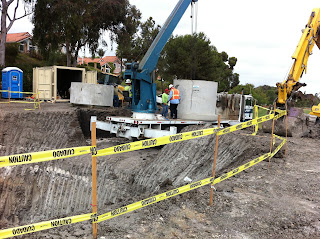The maintenance department's priority list extends from the cup outwards. So greens come first, followed by collars, approaches, fairways, tees, green surrounds and rough. Just because rough is last, doesn't mean we haven't been working on it.
The rough at Bernardo Heights Country Club, like many other clubs, is a combination of many types of grasses. Some turf types fare better than others with our soils, irrigation water, and climate conditions. Bermuda is nearly indestructible and is the preferred grass for our roughs. However, some areas have very little bermuda. In these locations, we'll have to do our best with what we have.
Here is a short list of some of the problems in the rough with our intended solutions:
- Problem: Wrong turf type
- Solution: Let the bad turf die and the good turf flourish
- Solution: Seed, sod, and sprig what we need
- Problem: Tight soils
- Solution: Aerify (In the middle of our second aerification in the last 3 months)
- Problem: Water quality
- Solution: Apply wetting agents to improve infiltration (2nd app just finished yesterday)
- Solution: Use organic acids to break up sodium (2nd app is out)
- Problem: Fertility
- Solution: Include rough in regular fertility program (done)
- Problem: Irrigation efficiency
- Solution: Change nozzles in sprinkler heads (fairways are finished, rough is next)
- Solution: Raise low sprinkler heads (an ongoing battle with steady progress)
- Solution: Trim trees to allow path for irrigation (10 more trees today alone)
Notice that not a single solution involved more irrigation. Once again, more water is not the answer.
Now for a few pictures:
First up, a photo of the rough between the bunker and fairway on #17, much improved going into this summer. The main reason was the two shots of fertilizer applied so far this season. Most of our rough is not this thick or dense. This is a good example of a blend of ryegrass and bermuda, the best of both worlds. If the rye losses out to the heat, the bermuda should fill in easily.
The picture to the left is an example of some problem rough. This is mostly ryegrass and bermuda with depressions or pits where the poa annua has died. If we have a lot of bermuda here, it will slowly fill the voids. If there is mostly rye, then these pits are going to be a problem for a while.
Most of these areas have a bunch of thatch which comes from the annual cycle of Poa annua germination and subsequent death. The roots left behind add to the 2-3 inch mat that already exists. We have to remove this biomass to get grass to grow with some roots in the soil. This will be achieved with aerification. Once the Senior Amateur Qualifier is concluded next Monday, we get a break from tournaments and will really go after these areas.
The next two photos are different angles of the same area. There are clumps of poa annua and ryegrass in a low bed of bermuda. Here we will remove the cool season grasses and encourage the bermuda to fill in and grow strong.

Finally, our rough suffers from many forms of compaction, but none so common as the beloved golf cart. I support a handicap flag program and agree that this course is fairly difficult to walk. So please, by all means, take your carts and drive where you need to go. Just keep this in mind: if you find yourself this close to the cartpath, you might do us all a favor and walk the extra four feet. The grass will thank you.
 On Monday, the wet well was installed at the site of our new pump house. The wet well is a water-filled vault (will be water-filled soon) that is positioned under the pump house. The motors that were delivered Tuesday will draw up water straight from the wet well underneath. The pad for the pump house will be poured on Thursday and pump house delivery is next Monday.
On Monday, the wet well was installed at the site of our new pump house. The wet well is a water-filled vault (will be water-filled soon) that is positioned under the pump house. The motors that were delivered Tuesday will draw up water straight from the wet well underneath. The pad for the pump house will be poured on Thursday and pump house delivery is next Monday.


















